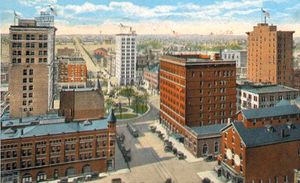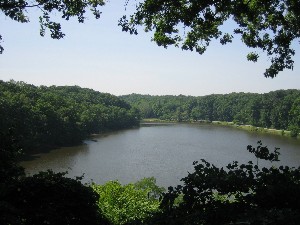Youngstown and the Mahoning Valley
Youngstown, with 80,000 residents, is one of the main cities in the
state of Ohio. Youngstown is located in the northeast region of the
state, near the border of Ohio and Pennsylvania. The Mahoning River
flows through downtown Youngstown, and eventually joins the larger Ohio
River. Youngstown is the central city of the Mahoning Valley, a
metropolitan area with 700,000 inhabitants.
Native
Americans were the first inhabitants of the Mahoning Valley, and the
word "Mahoning" is derived from another Indian word meaning "at the
salt lick". Various Native American tribes have inhabited the rivers
and land of the Mahoning Valley over the past 15,000 years, using the
area for its abundance of salt, flint, and hunting opportunties. When
European explorers reached this area of North America, the region was
considered to be between the lands of the Iroquois and the Shawnee
tribes.
John Young
purchased 15,560 acres of the Western Reserve claimed by the state of
Connecticut, and in 1797, founded the community of Youngstown along the
Mahoning River. Daniel and James Heaton became the area's first
industrialists as they built the Hopewell Furnace in 1802 to smelt
metal using the area's rich coal deposits. The iron industry of the
area grew as transportation and infrastructure developments were made.
Canals were built in the 1820s and railroads were constructed in the
1850s linking the Mahoning Valley to the rest of the country. The
area's first steel mill began operation in 1892 in Youngstown.

Postcard, Downtown Youngstown in 1910
Youngstown
and the "Steel Valley" quickly became one of the largest manufacturing
regions in the United States. Many immigrants from Europe settled in
the area to find work in local industry. By 1920, Youngstown was the
50th largest U.S. city by population and was the second largest steel
producing area in the country, with nearby Pittsburgh being the
largest. The region continued to gain population and wealth during the
Second World War and by this time, Youngstown and the Mahoning Valley
had several thriving Slovak neighborhoods, with Slovak-Americans
contributing to the cultural heritage of the area.
In
the second half of the 20th century, Youngstown's manufacturing base
declined as foreign competition, business costs, industry
consolidation, and moderinization issues produced complications for
local businesses. Other sectors of the economy such as logistics and
distribution, precision manufacturing, and software development have
become important components of Youngstown's regional economy.
Besides
its industrial heritage, Youngstown is today known for many outstanding
attributes. One is Mill Creek Park, filled with natural wooded
landscapes, flowering gardens, and recreational activites located in
the heart of the city. Another is Youngstown State University, whose
campus downtown has 13,000 students enrolled in various studies. The
neighborhoods of Youngstown contain many churches and restaurants that
reflect the cultural influences of immigrants throughout the city's
existence.

Youngstown continues to be the commercial, educational, and cultural center of the Mahoning Valley.
The mayor of Youngstown is Jamael Tito Brown, and the website of the city council can be found at: www.cityofyoungstownoh.org
The
city of Youngstown and Youngstown State University have recently
coordinated their efforts to create a master plan to guide their
efforts in the coming decades. This plan can be accessed at www.youngstown2010.com
revised 10-Feb-2014
|

